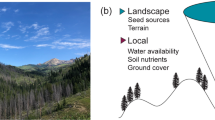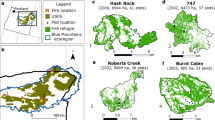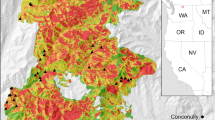Abstract
Context
Distance to seed source is often used to estimate seed dispersal—a process needed for post-fire tree recovery. However, distance, especially in mountainous terrain, does not capture pattern or scale-dependent effects controlling seed supply and delivery. Measuring seed source pattern (area and arrangement) could provide insights on how these spatial dynamics shape recovery.
Objectives
We tested metrics and investigated how seed source pattern, tree regeneration traits, scale, and terrain interact to shape post-fire tree recovery. Our research questions were: Does seed source pattern outperform distance when modeling tree species presence and regeneration density? If yes, does seed source pattern have scale-dependent or terrain-dependent effects on regeneration density?
Methods
We measured seed source pattern at nested spatial extents around 71 plots and related measurements to local post-fire tree recovery. We used generalized linear models to test metrics and visualize scale-dependent and terrain-dependent effects on regeneration density.
Results
Distance sufficiently modeled presence, but seed source pattern outperformed distance when modeling regeneration density. Relevant spatial extents and relationships were species-dependent. For wind-dispersed species, regeneration was associated with more seed source area and more complex arrangements, but terrain mediated these relationships. For serotinous and resprouting species, regeneration was associated with less seed source area and less complex arrangements, which are consistent with high-severity burn sites that promote recovery.
Conclusions
Seed source pattern supports spatial resilience and interacts with scale and terrain to shape regeneration density. Accounting for these spatial dynamics could help steward forests facing changing fire regimes.







Similar content being viewed by others
References
Abatzoglou JT, Williams AP (2016) Impact of anthropogenic climate change on wildfire across western US forests. Proc Natl Acad Sci USA 113:11770–11775
Addicott JF, Aho JM, Antolin MF, Padilla DK, Richardson JS, Soluk DA (1987) Ecological neighborhoods scaling environmental patterns. Oikos 49:340–346
Balch JK, Bradley BA, Abatzoglou JT, Nagy RC, Fusco EJ, Manhood AL (2017) Human-started wildfires expand the fire niche across the United States. Proc Natl Acad Sci USA 114:2946–2951
Buma B, Brown CD, Donato DC, Fontaine JB, Johnstone JF (2013) The impacts of changing disturbance regimes on serotinous plant populations and communities. Bioscience 63:866–876
Carpenter S, Walker B, Anderies JM, Abel N (2011) From metaphor to measurement: resilience of what to what? Ecosystems 4:765–781
Clark JS, Silman M, Kern R, Macklin E, Hille Ris Lambers J (1999) Seed dispersal near and far: patterns across temperate and topical forests. Ecology 80:1475–1494
Collins BM, Stevens JT, Miller JD, Stephens SL, Brown PM, North MP (2017) Alternative characterization of forest fire regimes: incorporating spatial patterns. Landsc Ecol 32:1543–1552
Coop JD, DeLory TJ, Downing WM, Haire SL, Krawchuk MA, Miller C, Parisien MA, Walker RB (2019) Contributions of fire refugia to resilient ponderosa pine and dry mixed-conifer forest landscapes. Ecosphere 10:e02809
Cumming GS (2011) Spatial resilience: Integrating landscape ecology, resilience, and sustainability. Landsc Ecol 26:899–909
Cumming GS, Morrison TH, Hughes TP (2017) New directions for understanding the spatial resilience of social–ecological systems. Ecosystems 20:649–664
Damschen EI, Baker DV, Bohrer G, Nathan R, Orrock JL, Turner JR, Brudvig LA, Haddad NM, Levey DJ, Tewksbury JJ (2014) How fragmentation and corridors affect wind dynamics and seed dispersal in open habitats. Proc Natl Acad Sci USA 111:3484–3489
Dennison PE, Brewer SC, Arnold JD, Moritz MA (2014) Large wildfire trends in the western United States, 1984–2011. Geophys Res Lett 41:6413–6419
Dobrowski SZ (2011) A climate basis for microrefugia: the influence of terrain on climate. Glob Change Biol 17:1022–1035
Donato DC, Harvey BJ, Turner MG (2016) Regeneration of montane forests 24 years after the 1988 Yellowstone fires: a fire-catalyzed shift in lower treelines? Ecosphere 7:e01410
Downing WM, Krawchuk MA, Meigs GW, Haire SL, Coop JD, Walker RB, Whitman E, Chong G, Miller C (2019) Influence of fire refugia spatial pattern on post-fire forest recovery in Oregon’s Blue Mountains. Landsc Ecol 34:771–792
Greene DF, Canham CD, David Coates K, Lepage PT (2004) An evaluation of alternative dispersal functions for trees. J Ecol 92:758–766
Greene DF, Johnson EA (1996) Wind dispersal of seeds from a forest into a clearing. Ecology 77:596–609
Haire SL, McGarigal K (2010) Effects of landscape patterns of fire severity on regenerating ponderosa pine forests (Pinus ponderosa) in New Mexico and Arizona, USA. Landsc Ecol 25:1055–1069
Halofsky JE, Donato DC, Hibbs DE, Cambell JL, Cannon MD, Fontaine JB, Thompson JR, Anthony RG, Bormann BT, Kayes LJ, Law BE, Peterson DL, Spies TA (2011) Mixed-severity fire regimes: lessons and hypotheses from the Klamath-Siskiyou Ecoregion. Ecosphere 2:art40
Hansen WD, Braziunas KH, Rammer W, Seidl R, Turner MG (2018) It takes a few to tango: changing climate and fire regimes can cause regeneration failure of two subalpine conifers. Ecology 99:966–977
Hansen WD, Turner MG (2019) Origins of abrupt change? Postfire subalpine conifer regeneration declines nonlinearly with warming and drying. Ecol Monogr 89:e01340
Harvey BJ, Donato DC, Turner MG (2016) High and dry: Post-fire tree seedling establishment in subalpine forests decreases with post-fire drought and large stand-replacing burn patches. Glob Ecol Biogeogr 25:655–669
Hesselbarth MHK, Sciaini M, With KA, Wiegand K, Nowosad J (2019) landscapemetrics: an open-source R tool to calculate landscape metrics. Ecography 42:1648–1657
Katul GG, Poggi D (2012) The effects of gentle topographic variation on dispersal kernels of inertial particles. Geophys Res Lett 39:L03401
Kemp KB, Higuera PE, Morgan P (2016) Fire legacies impact conifer regeneration across environmental gradients in the U.S. northern Rockies. Landsc Ecol 31:619–636
Krawchuk MA, Haire SL, Coop J, Parisien M, Whitman E, Chong G, Miller C (2016) Topographic and fire weather controls of fire refugia in forested ecosystems of northwestern North America. Ecosphere 7:e01632
Landesmann JB, Morales JM (2018) The importance of fire refugia in the recolonization of a fire-sensitive conifer in northern Patagonia. Plant Ecol 219:455–466
Leroux SJ (2019) On the prevalence of uninformative parameters in statistical models applying model selection in applied ecology. PLoS ONE 14:e0206711
Loope LL, Gruell GE (1973) The ecological role of fire in the Jackson Hole area, northwestern Wyoming. Quat Res 3:425–443
Lotan J (1976) Cone serotiny – fire relationships in lodgepole pine. Proc Tall Timbers Fire Ecol Conf 14:267–278
Lyon LJ, Stickney PF (1974) Early vegetal succession following large northern Rocky Mountain fires. Proc Tall Timbers Fire Ecol Conf 14:355–375
McCaughey WW, Schmidt W, Shearer RC (1986) Seed dispersal characteristics of conifers in the inland mountain west. In: Proceedings – Conifer Tree Seed in the Inland Mountain West Symposium. United States Forest Service, Department of Agriculture, General Technical Report INT-203, pp 50–62
Meddens AJH, Kolden CA, Lutz JA, Smith AMS, Cansler CA, Abatzoglou JT, Meigs GW, Downing WM, Krawchuk MA (2018) Fire refugia: what are they, and why do they matter for global change? Bioscience 68:944–954
O’Neill RV (1989) Transmutations across hierarchical levels. In: Innis GS, O’Neill RV (eds) Systems analysis of ecosystems. International Cooperative Publishing House, Maryland, pp 59–78
Oksanen J, Blanchet FG, Friendly M, Kindt R, Legendre P, McGlinn D, Minchin PR, O'Hara RB, Simpson GL, Solymos P, Stevens MHH, Szoecs E, Wagner H (2019) vegan: community ecology package. R package version 2.5-6. https://CRAN.R-project.org/package=vegan. Accessed 24 Jan 2020
Reader RJ, Buck J (1986) Topographic variation in the abundance of Hieracium floribundum: relative importance of differential seed dispersal, seedling establishment, plant survival and reproduction. J Ecol 74:815–822
Riitters KH, O’Neill RV, Hunsaker CT, Wickham JD, Yankee DH, Timmins SP, Jones KB, Jackson BL (1995) A factor analysis of landscape pattern and structure metrics. Landsc Ecol 10:23–39
Román-Cuesta RM, Gracia M, Retena J (2009) Factors influencing the formation of unburned forest islands within the perimeter of a large forest fire. For Ecol Manag 258:71–80
Rother MT, Veblen TT (2016) Limited conifer regeneration following wildfires in dry ponderosa pine forests of the Colorado Front Range. Ecosphere 7:e01594
Rother MT, Veblen TT, Furman LG (2015) A field experiment informs expected patterns of conifer regeneration after disturbance under changing climate conditions. Can J For Res 45:1607–1616
Rowe JS (1983) Concepts of fire effects on plant individuals and species. In: Wein RW, MacLean DA (eds) The role of fire in North Circumpolar ecosystems. Wiley, New Jersey, pp 135–154
Schoennagel T, Turner MG, Romme WH (2003) The influence of fire interval and serotiny on postfire lodgepole pine density in Yellowstone National Park. Ecology 84:2967–2978
Stevens JT, Collins BM, Miller JD, North MP, Stephens SL (2017) Changing spatial patterns of stand-replacing fire in California conifer forests. For Ecol Manag 406:28–36
Stevens-Rumann CS, Kemp KB, Higuera PE, Harvey BJ, Rother MT, Donato DC, Morgan P, Veblen TT (2017) Evidence for declining forest resilience to wildfires under climate change. Ecol Lett. https://doi.org/10.1111/ele.12889
Tautenhahn S, Lichstein JW, Jung M, Kattge J, Bohlman SA, Heilmeier H, Prokushkin A, Kahl A, Wirth C (2016) Dispersal limitation drives successional pathways in Central Siberian forests under current and intensified fire regimes. Glob Chang Biol 22:2178–2197
Tepley AJ, Thompson JR, Epstein HE, Anderson-Teixeira KJ (2017) Vulnerability to forest loss through altered postfire recovery dynamics in a warming climate in the Klamath Mountains. Glob Chang Biol 23:4117–4132
Tischendorf L, Fahrig L (2000) On the usage and measurement of landscape connectivity. Oikos 90:7–19
Trakhtenbrot A, Katul GG, Nathan R (2014) Mechanistic modeling of seed dispersal by wind over hilly terrain. Ecol Model 274:29–40
Turner MG (2005) Landscape ecology: what is the state of the science? Annu Rev Ecol Evol Syst 36:319–344
Turner MG, Braziunas KH, Hansen WD, Harvey BJ (2019) Short-interval severe fire erodes the resilience of subalpine lodgepole pine forests. Proc Natl Acad Sci USA 166:11319–11328
Turner MG, Romme WH, Gardner RH, Hargrove WW (1997) Effects of fire size and pattern on early succession in Yellowstone National Park. Ecol Monogr 67:411–433
Turner MG, Romme WH, Reed RA, Tuskan GA (2003a) Post-fire aspen seedling recruitment across the Yellowstone (USA) Landscape. Landsc Ecol 18:127–140
Turner MG, Romme WH, Tinker DB (2003b) Surprises and lessons from the 1988 Yellowstone fires. Front Ecol Environ 1:351–358
Venables WN, Ripley BD (2002) Modern applied statistics with S. Springer, New York
Wagenmakers EJ, Farrell S (2004) AIC model selection using Akaike weights. Psychon Bull Rev 11:192–196
Walker B, Holling CS, Carpenter SR, Kinzig A (2004) Resilience, adaptability and transformability in social-ecological systems. Ecol Soc 9:5
Walker RB, Coop JD, Downing WM, Krawchuk MA, Malone SL, Meigs GW (2019) How much forest persists through fire? High-resolution mapping of tree cover to characterize the abundance and spatial pattern of fire refugia across mosaics of burn severity. Forests 10:782
Westerling AL (2016) Increasing western US forest wildfire activity: sensitivity to changes in the timing of spring. Philos Trans R Soc Lond B Biol Sci 371:717–728
Wiens JA (1989) Spatial scaling in ecology. Funct Ecol 3:385–397
Wildland Fire Leadership Council (2014) A National Cohesive Wildland Fire Management Strategy. https://www.forestsandrangelands.gov/documents/strategy/strategy/CSPhaseIIINationalStrategyApr2014.pdf. Accessed 24 Jan 2020
Zakšek K, Oštir K, Kokalj Ž (2011) Sky-view factor as a relief visualization technique. Remote Sens 3:398–415
Acknowledgements
The National Science Foundation (BCS-1901630), Joint Fire Science Program (1910144), National Geographic, National Aeronautics and Space Administration Pennsylvania Space Grant Consortium, and Penn State Center for Landscape Dynamics funded the study. We thank Hunter Mitchell and Shaina Walker for their hard work in the field, as well as Shelby Duncan for their assistance with the object based image analysis. We also thank Diane Abendroth and Bridger-Teton National Forest for their logistical support and permitting the study. Laura Leites, Doug Miller, and Alan Taylor served on JLP’s dissertation committee and provided helpful feedback on the manuscript and study.
Author information
Authors and Affiliations
Corresponding author
Additional information
Publisher's Note
Springer Nature remains neutral with regard to jurisdictional claims in published maps and institutional affiliations.
Electronic supplementary material
Below is the link to the electronic supplementary material.
Rights and permissions
About this article
Cite this article
Peeler, J.L., Smithwick, E.A.H. Seed source pattern and terrain have scale-dependent effects on post-fire tree recovery. Landscape Ecol 35, 1945–1959 (2020). https://doi.org/10.1007/s10980-020-01071-z
Received:
Accepted:
Published:
Issue Date:
DOI: https://doi.org/10.1007/s10980-020-01071-z




